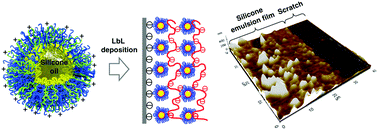当前位置:
X-MOL 学术
›
Soft Matter
›
论文详情
Our official English website, www.x-mol.net, welcomes your
feedback! (Note: you will need to create a separate account there.)
Highly stable, electrostatically attractive silicone nanoemulsions produced by interfacial assembly of amphiphilic triblock copolymers
Soft Matter ( IF 2.9 ) Pub Date : 2018-05-30 00:00:00 , DOI: 10.1039/c8sm00187a Hanhee Park 1, 2, 3, 4 , Kyounghee Shin 2, 4, 5, 6, 7 , Jin Yong Lee 2, 4, 5, 6 , Ji Eun Kim 2, 4, 5, 6 , Hye Min Seo 2, 4, 5, 6 , Jin Woong Kim 1, 2, 3, 4, 5
Soft Matter ( IF 2.9 ) Pub Date : 2018-05-30 00:00:00 , DOI: 10.1039/c8sm00187a Hanhee Park 1, 2, 3, 4 , Kyounghee Shin 2, 4, 5, 6, 7 , Jin Yong Lee 2, 4, 5, 6 , Ji Eun Kim 2, 4, 5, 6 , Hye Min Seo 2, 4, 5, 6 , Jin Woong Kim 1, 2, 3, 4, 5
Affiliation

|
This article presents a useful and promising approach for fabricating extremely stable silicone oil nanoemulsions, whose liquid–liquid interface is structured with a thin film of amphiphilic triblock copolymers. For this, two types of amphiphilic triblock polymer, poly(2-methacryloyloxy ethyl phosphorylcholine)-block-poly(ε-caprolactone)-block-poly(2-methacryloyloxy ethyl phosphorylcholine) (PMPC–PCL–PMPC) and poly(2-aminoethyl methacrylate)-block-poly(ε-caprolactone)-block-poly(2-aminoethyl methacrylate) (PAMA–PCL–PAMA), were synthesized by atom transfer radical polymerization. Employing the phase separation technique was critical for the formation of thin polymer interfaces, of less than 10 nm, thus eventually producing structurally stable silicone oil nanoemulsions. The co-assembly of PAMA–PCL–PAMA with PMPC–PCL–PMPC enabled the patching of positive charges on the surface of the emulsion drops. We show that these charged silicone oil nanoemulsions could be used to form a multilayer emulsion thin film by layer-by-layer deposition. Finally, we experimentally demonstrate that the silicone oil nanoemulsions fabricated in this way were highly stable and had the ability to electrostatically interact with hair, which enabled complete coating of the hair surface with a layer of silicone oil.
中文翻译:

两亲三嵌段共聚物的界面组装产生的高度稳定的,具有静电吸引力的有机硅纳米乳液
本文提出了一种有用且有前途的方法,用于制造极其稳定的硅油纳米乳液,该乳液的液-液界面由两亲三嵌段共聚物薄膜构成。对于这一点,两种两亲性三嵌段聚合物,聚(2-甲基丙烯酰氧基乙基磷酰胆碱) -嵌段-聚(ε -己内酯) -嵌段-聚(2-甲基丙烯酰氧基乙基磷酰胆碱)(PMPC-PCL-PMPC)和聚(2-氨基甲基丙烯酸乙酯) -嵌段-聚(ε -己内酯) -嵌段-聚(甲基丙烯酸2-氨基乙基酯)(PAMA–PCL–PAMA)是通过原子转移自由基聚合反应合成的。采用相分离技术对于形成小于10 nm的薄聚合物界面至关重要,从而最终生产出结构稳定的硅油纳米乳液。PAMA–PCL–PAMA与PMPC–PCL–PMPC的共同组装可在乳剂液滴表面上修补正电荷。我们表明,这些带电的硅油纳米乳液可用于通过逐层沉积形成多层乳液薄膜。最后,我们实验证明以这种方式制备的硅油纳米乳液具有很高的稳定性,并具有与头发发生静电相互作用的能力,从而能够在硅脂表面上完全覆盖一层硅油。
更新日期:2018-05-30
中文翻译:

两亲三嵌段共聚物的界面组装产生的高度稳定的,具有静电吸引力的有机硅纳米乳液
本文提出了一种有用且有前途的方法,用于制造极其稳定的硅油纳米乳液,该乳液的液-液界面由两亲三嵌段共聚物薄膜构成。对于这一点,两种两亲性三嵌段聚合物,聚(2-甲基丙烯酰氧基乙基磷酰胆碱) -嵌段-聚(ε -己内酯) -嵌段-聚(2-甲基丙烯酰氧基乙基磷酰胆碱)(PMPC-PCL-PMPC)和聚(2-氨基甲基丙烯酸乙酯) -嵌段-聚(ε -己内酯) -嵌段-聚(甲基丙烯酸2-氨基乙基酯)(PAMA–PCL–PAMA)是通过原子转移自由基聚合反应合成的。采用相分离技术对于形成小于10 nm的薄聚合物界面至关重要,从而最终生产出结构稳定的硅油纳米乳液。PAMA–PCL–PAMA与PMPC–PCL–PMPC的共同组装可在乳剂液滴表面上修补正电荷。我们表明,这些带电的硅油纳米乳液可用于通过逐层沉积形成多层乳液薄膜。最后,我们实验证明以这种方式制备的硅油纳米乳液具有很高的稳定性,并具有与头发发生静电相互作用的能力,从而能够在硅脂表面上完全覆盖一层硅油。











































 京公网安备 11010802027423号
京公网安备 11010802027423号